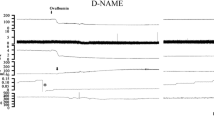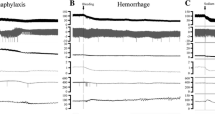Abstract
Nitric oxide, synthesized from the guanidino group ofl-arginine by nitric oxide synthase, has an important role in pathophysiological changes associated with anaphylaxis. Nitric oxide production due to activation of constitutive nitric oxide synthase is detected using a nitric oxide-selective electrode in anaphylactic rabbitsin vivo. A nitric oxide synthase inhibitor attenuates hypotension and hemoconcentration and decreases venous return but does not improve cardiac depression. Nitric oxide functionally antagonizes the effects of vasoconstrictors released by anaphylaxisin vitro. In animals pretreated with a nitric oxide synthase inhibitor, the cardiac output falls significantly, although venous return is increased. Pulmonary resistance is significantly increased with a nitric oxide synthase inhibitor, andl-arginine attenuates the bronchospasm. These findings suggest that production of nitric oxide may reduce the pathophysiologic changes, except for vasodilatation, associated with anaphylaxis.
Similar content being viewed by others
References
Furchgott RF, Zawadzxi JW: The obligatory role of endothelial cells in the relaxation of vascular smooth muscle by acetylcholine. Nature 288:373–376, 1980
Moncada S, Higgs A: The L-arginine-nitric oxide pathway. N Engl J Med 329:2002–2012, 1993
Förstermann U, Schmidt HHHW, Pollock J, Sheng H, Michell JA, Warner TD, Nakane M, Murad F: Isoforms of nitric oxide synthase: Characterization and purification from different cell types. Biochem Pharmacol 42:1849–1857, 1991
Moncada S, Higgs EA: Endogenous nitric oxide: Physiology, pathology and clinical relevance. Eur J Clin Invest 21:361–374, 1991
Moncada S, Palmer RMJ, Higgs EA: Nitric oxide: Physiology, pathology, and pharmacology. Pharmacol Rev 43:109–142, 1991
Quinn AC, Petros AJ, Vallance P: Nitric oxide: An endogenous gas. Br J Anaesth 74:443–451, 1995
Thiemermann C: The role of the L-arginine: Nitric oxide pathway in circulatory shock. Adv Pharmacol 28:45–79, 1994
Palmer RMJ, Ferridge AG, Moncada S: Nitric oxide release accounts for biological activity of endothelium derived relaxing factor. Nature 327:524–526, 1987
Palmer RMJ, Ashton DS, Moncada S: Vascular endothelial cells synthesize nitric oxide froml-arginine. Nature 333:664–666, 1988
Szabó C: Alterations in nitric oxide production in various forms of circulatory shock. New Horizons 3:2–32, 1995
Johns RA: Endothelium, anesthetics, and vascular control. Anesthesiology 79:1381–1391, 1993
Kam PCA, Govender G: Nitric oxide: Basic science and clinical applications. Anaesthesia 49:515–521, 1994
Szabó C, Thiermann C: Invited opinion: Role of nitric oxide in hemorrhagic, traumatic, and anaphylactic shock and thermal injury. Shock 2:145–155, 1994
Cipolle MD, Pasquale MD, Cerra FB: Secondary organ dysfunction. From clinical perspectives to molecular mediators. Circ Shock 9:261–296, 1993
Lefer AM, Lefer DJ: Pharmacology of the endothelium in ischemia-reperfusion and circulatory shock. Annu Rev Pharmacol Toxicol 33:71–90, 1993
Griffiths MJD, Curzen NP, Sair M, Evans TW: Nitric oxide synthase inhibitors in septic shock: theoretical considerations. Clin Intens Care 5:29–36, 1994
Wright CE, Rees DD, Moncada S: Protective and pathological roles of nitric oxide in endotoxin shock. Cardiovasc Res 26:48–57, 1992
Thiemermann C, Wu C-C, Szabó C, Perreti M, Vane JR: Role of tumor necrosis factor in the induction of nitric oxide synthase in a rat model of endotoxin shock. Br J Pharmacol 110:117–182, 1993
Amir S, English AM: An inhibitor of nitric oxide production, NG-nitro-l-arginine-methyl ester, improves survival in anaphylactic shock. Eur J Pharmacol 203:125–127, 1991
Mitsuhata H, Saitoh J, Takeuchi H, Hasome N, Horiguchi Y, Shimizu R: Production of nitric oxide in anaphylaxis in rabbits. Shock 2:381–384, 1994
Szabó C, Wu CC, Thiemermann C, Vane JR: Role of the constitutive and inducible nitric oxide synthetases in the cardiovascular response in systemic anaphylaxis in the rat. Br J Pharmacol 110:31, 1993 (abstr)
Osada S, Ichiki H, Oku H, Ishiguro K, Kunitomo M, Semma M: Participation of nitric oxide in mouse anaphylactic hypotension. Eur J Pharmacol 252:347–350, 1994
Rees DD, Cellek S, Palmer RMJ, Moncada S: Dexamethasone prevents the induction of a nitric oxide synthase and the associated effects on the vascular tone: An insight into endotoxic shock. Biochem Biophy Res Commun 173:541–547, 1990
Thiemermann C, Szabó C, Mitchell JA, Vane JR: Vascular hyporeactivity to vasoconstrictor agents and hemodynamic decompensation in hemorrhagic shock is mediated by nitric oxide. Proc Natl Acad Sci USA 90:267–271, 1993
Krstic MK, Stepanovic RM, Krstie SK, Katusic ZS: Endothelium dependent relaxation of the rat renal artery caused by activation of histamine H1 receptors. Pharmacology 38:113–120, 1989
Takekoshi K, Kasai K, Sekiguchi Y, Banba N, Nakamura T, Shimoda SI: Effect of NG-nitro-l-arginine on shock induced by endotoxin and by platelet activating factor in dogs. Eur J Pharmacol 250:465–467, 1993
Szabó C, Mitchell JA, Gross SS, Thiemermann CC, Vane JR: Platelet-activating factor contributes to the induction of nitric oxide synthase by bacterial lipopolysaccharide. Circ Res 73:991–999, 1993
Moritoki H, Hisayama T, Takeuchi S, Miyano H, Kondoh W: Involvement of nitric oxide in the PAF-induced relaxation of rat thoracic aorta. Br J Pharmacol 107:196–201, 1992
Pawloski JR, Chapnick BM: Leukotrienes C4 and D4 are potent endothelium-dependent relaxing agents in canine splanchnic venous capacitance vessels. Circ Res 73:395–404, 1993
Van de Voorde J, Leusen I: Role of the endothelium in the vasodilator response of rat thoracic aorta to histamine. Eur J Pharmacol 87:113–120, 1983
Wagner EM, Mitzner WA, Bleecker ER: Peripheral circulatory alterations in canine anaphylactic shock. Am J Physiol 251 (Heart Circ Physiol 20):H934-H940, 1986
Levi R, Lamparter B, Aisaka K, Gross SS, Grifith OW: Role of endothelium-derived nitric oxide in cardiac and systemic anaphylaxis. Circulation 82 (Suppl III):III-345, 1990 (abstr)
Mitsuhata H, Takeuchi H, Saitoh J, Hasome N, Horiguchi Y, Shimizu R: An inhibitor of nitric oxide synthase, NW-nitro-l-arginine-methyl ester, attenuates hypotension but does not improve cardiac depression in anaphylaxis in dogs. Shock 3:447–453, 1995
Correa E, Mink S, Unruh H, Kepron W: Left ventricular contractility is depressed in IgE-mediated anaphylactic shock in dogs. Am J Physiol 260 (Heart Circ Physiol 29):H744-H751, 1991
Cooper DJ: Cardiac dysfunction during anaphylaxis in patients. Appl Cardiopul Pathophysiol 5:9–18, 1993
Enjeti S, Bleecker ER, Smith PL, Rabson J, Permutt S, Traystman RJ: Hemodynamic mechanisms in anaphylaxis. Circ Shock 11: 297–309, 1983
Levi R: Cardiac anaphylaxis: Models, mediators, mechanisms and clinical considerations.In Human Inflammatory Disease. Clinical Immunology. Vol. 1, Marone G, Lichtenstein LM, Condorelli M, Faui AS (eds). Toronto, B. C. Decker, 1988, pp 93–105
Bakathir HA, Giessler J, Hirschelmann R: Rat heart anaphylaxis: Influence of mediator antagonists. Gen Pharmacol 22:673–675, 1991
Yamanaka S, Iwao H, Yukimura T, Kim S, Miura K: Effect of NG-nitro-l-arginine on effective vascular stiffness in dogs. Japan J Pharmacol 63:41–45, 1993
Griffith TM, Lewis MJ, Newby AC, Henderson AH: Endotheliumderived relaxing factor. J Am Coll Cardiol 12:797–806, 1988
Amezcua JL, Palmer RMJ, de Souza BM, Moncada S: Nitric oxide synthesized froml-arginine regulates vascular tone in the coronary circulation of the rabbit. Br J Pharmacol 97:1119–1124, 1989
Thelen KI, Dembinska-Kiéc A, Pallapies D, Simmet Th, Peskar BA: Effect of 3-morpholinosydnonimine (SIN-1) and NG-nitro-l-arginine (NNA) on isolated perfused anaphylactic guinea-pig hearts. Naunyn-Schmiedeberg Arch Pharmacol 345:93–99, 1992
Pallapies D, Thelen K, Dembinska-Kiec A, Simmet Th, Pesker BA: Effect of 3-morpholinosydnonimine (SIN-1), NGGr-nitro-l-arginine (NNA) and NG-monomethyl-l-arginine (NMMA) on isolated anaphylactic guinea-pig hearts. Agents Actions Suppl 37:114–119, 1992
Lamparter B, Gross SS, Griffith OW, Levi R: Endothelium-derived nitric oxide plays a role in cardiac anaphylaxis. Arch Int Pharmacol Ther 305:261, 1990 (abstr)
Mitsuhata H, Saitoh J, Hasome H, Takeuchi H, Horiguchi Y, Shimizu R: Nitric oxide synthase inhibition is detrimental to cardiac function and promotes bronchospasm in anaphylaxis in rabbits. Shock 4:143–148, 1995
Masini E, Gambassi F, Di Bello MG, Mugnai L, Raspanti S, Mannaioni PF: Nitric oxide modulates cardiac and mast cell anaphylaxis. Agents Actions 41 Spec Issue: C89-C90, 1994
Klabunde RE, Coston AF: Nitric oxide synthase inhibition does not prevent cardiac depression in endotoxic shock. Shock 3:73–78, 1995
Klabunde RE, Ritger RC: NG-Monomethyl-l-arginine (NMA) restores arterial blood pressure but reduces cardiac output in a canine model of endotoxic shock. Biochem Biophys Res Commun 178:1135–1140, 1991
Pastor C, Teisseire B, Vicaut E, Payen D: Effects ofl-arginine andl-nitro-arginine treatment on blood pressure and cardiac output in a rabbit endotoxin shock model. Crit Care Med 22:465–469, 1994
Cobb JP, Natanson C, Hoffman WD,et al.: Nw-Amino-l-arginine, an inhibitor of nitric oxide synthase, raises vascular resistance but increases mortality rates in awake canines challenged with endotoxin. J Exp Med 176:1175–1182, 1992
Brown IP, Williams RL, McKirrnan MD, Limjoco UR, Gray CG: Nitric oxide synthase inhibition does not improve the hemodynamic response to hemorrhagic shock in dehydrated conscious swine. Shock 3:292–298, 1995
Minnard EA, Shou J, Naama H, Cech A, Gallagher H, Daly JM: Inhibition of nitric oxide synthesis is detrimental during endotoxemia. Arch Surg 129:142–148, 1994
Rubin LE, Levi R: Protective role of bradykinin in cardiac anaphylaxis. Coronary-vasodilating and antiarrhythmic activities mediated by autocrine/paracrine mechanisms. Circ Res 76:434–440, 1995
Rees DD, Palmer RMJ, Hodson HF, Moncada S: A specific inhibitor of nitric oxide formation froml-arginine attenuates endothelium-dependent relaxation. Br J Pharmacol 96:418–424, 1989
Barsan WG, Hedges JR, Syverud SA, Dalsey WC: A hemodynamic model for anaphylactic shock. Ann Emerg Med 14:834–839, 1985
Evans T, Carpenter A, Silva A, Cohen J: Inhibition of nitric oxide synthase in experimental gram-negative sepsis. J Infect Dis 169:343–349, 1994
Munakata M, Masaki Y, Sakuma I, Ukita H, Otsuka Y, Homma Y, Kawakami Y: Pharmacological differentiation of epithelium-derived relaxing factor from nitric oxide. J Appl Physiol 69:665–670, 1990
Sheng H, Ishii K, Murad F: Generation of an endothelium-derived relaxing factor-like substances in bovine tracheal smooth muscle. Am J Physiol 260:L489-L493, 1991
Hay DPW, Muccitelli RM, Page CP, Spina D: Correlation between airway epithelium-induced relaxation of rat aorta in the co-axial bioassay and cyclic nucleotide levels. Br J Pharmacol 105:954–958, 1992
Nijkamp FP, Van der Linde HJ, Folkerts G: Nitric oxide synthesis inhibitors induce airway hyperresponsiveness in the guinea pig in vivo and in vitro. Role of the epithelium. Am Rev Respir Dis 148:727–734, 1993
Adams III GK, Lichtenstein L: In vitro studies of antigen-induced bronchospasm: Effect of antihistamine and SRS-A antagonist on response of sensitized guinea pig and human airways to antigen. J Immunol 122:555–562, 1979
Lazarus SC, Chesrown SE, Frey MJ, Reed BR, Mjörndal TO, Gold WM: Experimental canine anaphylaxis: Cyclic nucleotides, histamine, and lung function. J Appl Physiol 46:919–926, 1979
Dusting GJ, Read MA, Stewart AG: Differential bioassay of endothelium-derived relaxing factor and nitric oxide on rabbit aorta and guinea-pig trachea. Br J Pharmacol 93:101P, 1988 (abstr)
Author information
Authors and Affiliations
Rights and permissions
About this article
Cite this article
Mitsuhata, H., Shimizu, R. & Yokoyama, M.M. Role of nitric oxide in anaphylactic shock. J Clin Immunol 15, 277–283 (1995). https://doi.org/10.1007/BF01541317
Accepted:
Issue Date:
DOI: https://doi.org/10.1007/BF01541317




